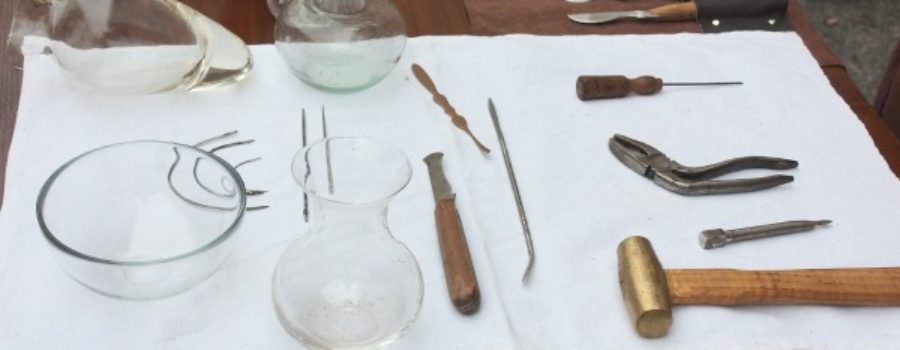Also known as: “thank goodness we live in a time when freezing is available!”
It’s not always pleasant to have dental work done – though dentists today have many means at their disposal to improve the customer’s experience. And all said and told, it’s a whole lot better than it used to be. Here, in brief, is a short history on the evolution of dentistry, with attributions to the American Dental Association, The Canadian Encyclopedia and the UofT Dentistry Library Blog.
Ancient origins:
5000 BC – Sumerian text of this date describes “tooth worms” as the leading cause of tooth decay.
2600 BC – This year marked the death of Hesy-Re, an Egyptian scribe, often called the first “dentist.” An inscription on his tomb includes the title “the greatest of those who deal with teeth, and of physicians.” This is the earliest known reference to a person identified as a dental practitioner.
166-201 AD – Ahead of their time in many areas, the Etruscans dominated dentistry as well, having developed dental prosthetics using gold crowns and fixed bridgework.
700 – A medical text in China mentions the use of “silver paste,” a type of amalgam. No word how different it was from what we use today but the origins are fascinating!
A little later in time
1530 – The Little Medicinal Book for All Kinds of Diseases and Infirmities of the Teeth (Artzney Buchlein), is published in Germany. It is the first book devoted entirely to dentistry and is written for barbers and surgeons who treat the mouth, covering topics such as oral hygiene, tooth extraction, drilling teeth, and placement of gold fillings.
1723 – Pierre Fauchard, a French surgeon publishes The Surgeon Dentist, A Treatise on Teeth (Le Chirurgien Dentiste). Fauchard is credited as being the Father of Modern Dentistry. His book was the first to describe the practice of dentistry in detail, including oral anatomy and function, operative and restorative techniques, and denture construction.
1789 – Frenchman Nicolas Dubois de Chemant receives the first known patent for porcelain teeth.
1815 – Mr L.S. Parmly, who practiced in Montréal, published the first Canadian book on dentistry, The Summum Bonum. Mr. Parmly called himself a dentist and “medical electrician.”
1832 – James Snell invents the first reclining dental chair.
Before 1859 – Dentistry was not an established profession in Canada. Tooth extraction was a part-time service performed by barber-dentists, gunsmiths, barrel makers, candy shop owners (how ironic!) and others. These ‘practitioners’ often manufactured their own instruments.
1867 – Nine dentists met in Toronto to form the Ontario Dental Association, and in 1868 the Royal College of Dental Surgeons of Ontario was established. Also in that year, The Canada Journal of Dental Science began publication. After several attempts from 1867 to 1870 to establish a school, the first dental college in Canada was founded, in Toronto, in 1875 by the Royal College of Dental Surgeons of Ontario.
1871 – James B. Morrison patented the first commercially available foot-treadle dental engine. Morrison’s inexpensive, mechanized tool supplied dental burs with enough speed to cut through enamel and dentin smoothly and quickly, revolutionizing the practice of dentistry.
1880s – The collapsible metal tube revolutionized toothpaste manufacturing: Dentifrice had been available up to that point in liquid or powder form, usually made by individual dentists, and sold in bottles, porcelain pots, or paper boxes. Tube toothpaste, in contrast, was mass-produced in factories, mass-marketed, and sold nation-wide.
1890 – Willoughby Miller notes the microbial basis of dental decay in his book Micro-Organisms of the Human Mouth. This starts a worldwide movement to promote regular toothbrushing and flossing.
1905 – Alfred Einhorn, a German chemist, formulates the local anesthetic procain, later marketed under the trade name Novocain. This was an important development in pain management and lead to more people undertaking dental procedures than ever before.
1938 – The nylon toothbrush, the first made with synthetic bristles, appears on the market. Prior to that, toothbrush bristles were made from natural fibres like hog hairs, which were coarse enough to do the job.
1950 – The first fluoride toothpastes are produced and mass-marketed.
1958 – A fully reclining dental chair is introduced.
1989 – The first commercial home tooth whitening product is marketed.
Times they have changed! Now, there are many ways dentists can make the experience relatively pain free and almost pleasant! As always, keep your pearly whites pearly by seeing your dentist regularly for a cleaning and talk to us about brightening your smile by arranging a teeth whitening visit at either of our Milton or Scarborough dental offices right away!








